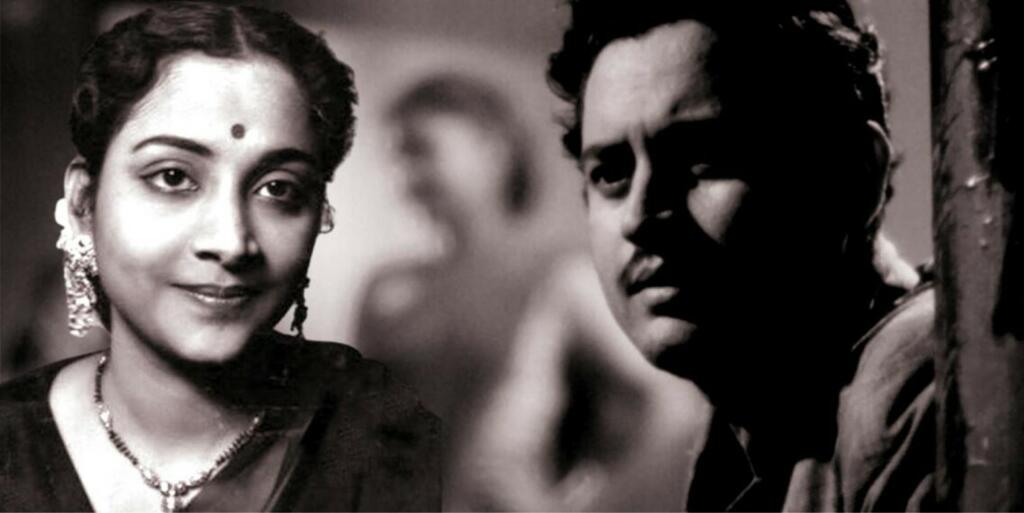Guru Dutt biography: There is a stark difference between reel – real, on-screen – off-screen, and actors – heroes. The majority of the so-called Superstars fake the ‘Good Acts’ in their movies and just do ACTING. These Fakesters don’t even try to be nice, humble and genuine in real life. They forget that they either become a role-model or a villain for the way they behave off-screen, not on screen. The legendary filmmaker Guru Dutt too was not immune to this. The reel-life superstar had a dark and tainted legacy in real life.
Tune o rangeele kaisa jadu kiya: Guru Dutt’s affairs hindered his Cinematic Progress
Vasant Kumar Shivshankar Padukone, better known as Guru Dutt was the most polite and gentle man on screen but he was an undisciplined, alcoholic and colourful person in real life. The talented filmmaker didn’t do Justice with his art as his affairs always changed the direction of his cinematic career. He was twice expelled from the organisations he was training or working with because of his in-house affairs.
Skill wise, Guru Dutt is widely praised for his art particularly for using close-up shots, lighting, and depictions of melancholia. He directed 8 Hindi films, virtually all of which gained a cult following internationally.
His movie Pyaasa (1957), was included in the list of Time magazine’s 100 Greatest Movies of all time. Apart from that, his movies Kaagaz Ke Phool (1959), Chaudhvin Ka Chand (1960) and Sahib Bibi Aur Ghulam (1962) are still considered among the greatest films in the history of Hindi cinema.
In 1953, he directed and starred in Baaz. The movie didn’t perform well but it brought together a team popularly known as ‘The Guru Dutt team’. The team did well in subsequent films. It included various filmmakers handpicked and mentored by Dutt like Johnny Walker (actor-comedian), V.K. Murthy (cinematographer), Abrar Alvi (writer-director), Raj Khosla (writer) and Waheeda Rehman (actress) among others.
Progression of his cinematic career
At 16 years of age, he started training at Uday Shankar’s School of Dancing and Choreography in Almora in 1941. He had an annual scholarship of Rs 75 for a full five years. However, in 1944, he was expelled for having an affair with the head dancer at the training institute.
Then he went to Calcutta and worked as a telephone operator in the Lever Brothers factory for some time. However, he soon became disillusioned, left the job and returned to his parents in Bombay the same year.
Later, his uncle sent him to work in films under a three-year contract with the acclaimed film production house Prabhat Film Company (PFC) in Poona. His initial contract with PFC ended in 1947. But his mother got him a job again as a freelance assistant with Baburao Pai, CEO of PFC.
It was at PFC that Dutt met actors Rehman and Dev Anand. They became his lifelong friends. Guru Dutt and Dev Anand even had a mutual understanding of giving each other a chance at a cinematic debut if one establishes himself in the industry. Later, this agreement did fructify and both worked together on several projects.
However, he lost this job too because of an affair. He was attracted to Vidya, a dancer in the PFC, and eloped with her. She was already engaged by that time and her fiancé went to the Police. The affair ended when the police took action. He was jobless for about 10 months and lived with his family in Matunga, Bombay.
Also Read: 6 Actors who overshadowed the film leads with their limited screen time
The Epitome of Goodness destroyed many lives
The darkest chapter in Guru Dutt’s life pertains to his love affair with two women Geeta Dutt and Waheeda Rehman. In a way, he betrayed both of them. Geeta Roy Chowdhuri, an acclaimed playback singer, fell in love with Guru Dutt and married him in 1953. But Guru Dutt had an unhappy marital life.
Guru Dutt fought a lot on the silver screen for the rights of backward classes and women, but in reality, it was the complete opposite. His drinking and affair with Waheeda Rehman made Geeta Dutt’s life a living hell.
Geeta Dutt could not sing for any other person or production house because of Guru Dutt. Interestingly, the songs in Kaagaz Ke Phool reflect her pain, which she could never display publicly.
On 10 October 1964, Guru Dutt was found dead in his apartment in Bombay. Reportedly, he overdosed on alcohol and sleeping pills hinting that it was either a suicide or an accidental overdose. Earlier, he had twice attempted to commit suicide. At the time of his death, he had separated from Geeta and was living alone. Geeta Dutt died in 1972 at age 41, after excessive drinking, which resulted in liver damage.
The legendary filmmaker in a very short span left an indelible mark on the Hindi Film industry and is still considered one of the greatest filmmakers of all time. But his self-destructive habits always shackled him and he could not do Justice with his enormous capabilities.
Support TFI:
Support us to strengthen the ‘Right’ ideology of cultural nationalism by purchasing the best quality garments from TFI-STORE.COM
